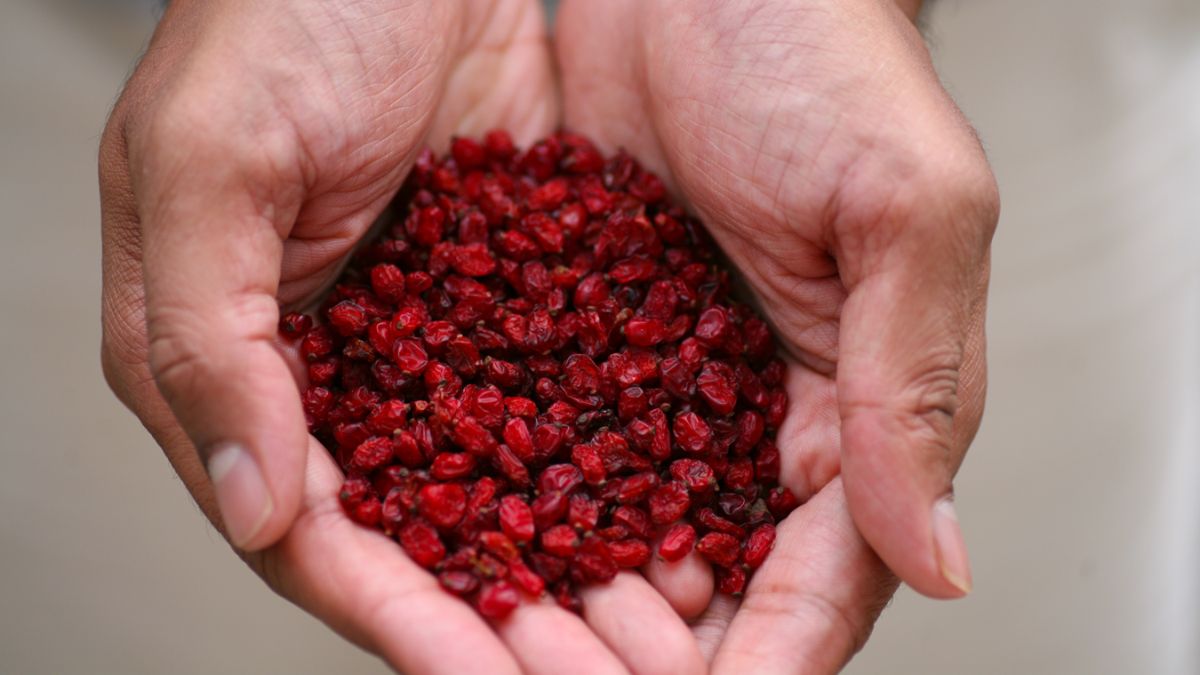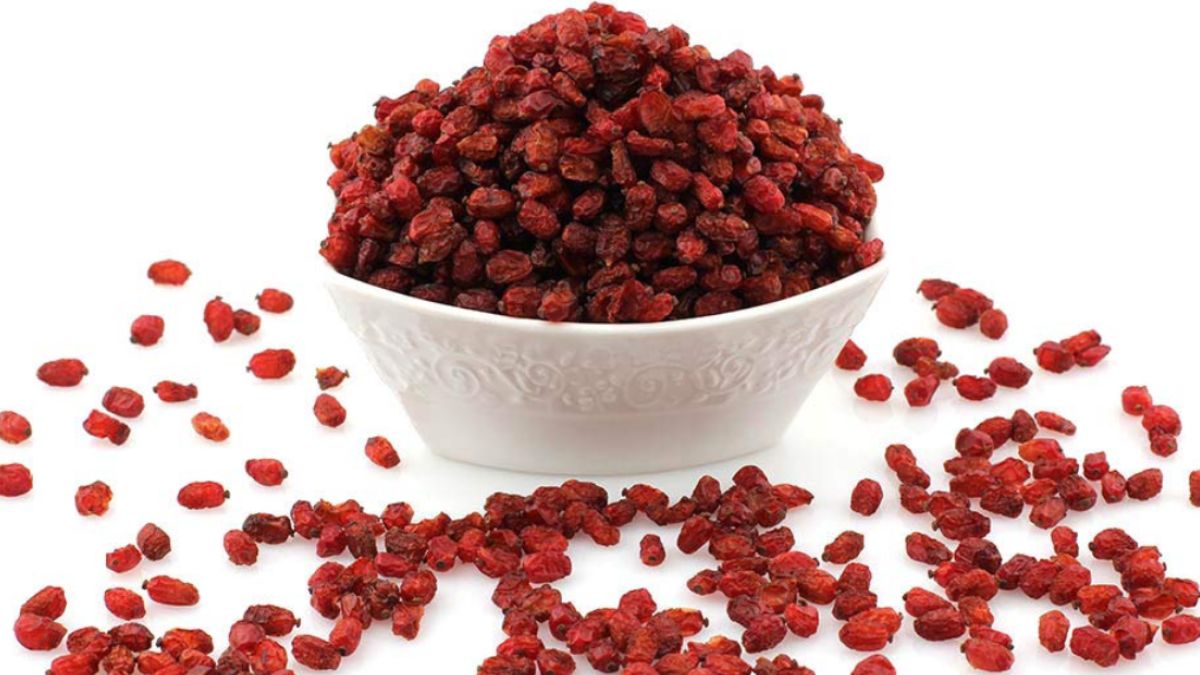Berberis vulgaris, or barberries, are long red berries that grow on trim barberry shrubs with yellow-flowering branches. Due to their widespread use in traditional medicine. Barberries have a distinct sour flavour that pairs well with savoury and sweet meals. Berberis (/barbers/), often known as barberry, is a broad genus of deciduous and evergreen shrubs that grow to be 1–5 m (3.3–16.4 ft) tall and can be found worldwide in temperate and subtropical climates (apart from Australia).
South America and Asia have the most species diversity, although Europe, Africa, and North America contain local species. Berberis vulgaris, the most well-known Berberis species, is native to Europe, North Africa, the Middle East, and Central Asia, and has been widely introduced in North America. Spines can be seen on the stems and all along the leaf margins in several species.
The fruit of the barberry shrub grows in bunches and can grow up to half an inch in length. These berries bloom bright crimson when fully ripe and have a particular flavour. Barberries are grown in many regions, including North Africa, Europe, the United States, and Canada, native Iran. In their native language, these berries are known as “Zereshk” and are used in many traditional Iranian dishes. Fresh barberries are a favourite snack in local markets as well.
What are Barberries?
Barberries are long red berries that grow on barberry shrubs with yellow blossoms on their branches. Barberries, also known as zereshk in Iran, have long been used in traditional medicine. An alkaloid found in tiny berries, Berberine can have adverse side effects in excessive doses.
What are the Types of Barberry?
4 Common Types of Barberry
2022 – MasterClass: Guide to Barberries: How to Use Barberries in Your Cooking
- European barberry (Berberis vulgaris) is the most common barberry variety in Middle Eastern cuisine.
- Japanese barberry (Berberis thunbergii) is most commonly planted as an ornamental.
- American barberry (Berberis canadensis) is native to North America.
- Oregon grape (Mahonia aquifolium), also known as the holly grape, is native to the Pacific Northwest.
What do Barberries Taste Like?
How to Cook with Barberries?
The most well-known barberry dish is probably Zereshk polo. Chicken is served on a bed of saffron rice studded with tiny dried barberries in this Persian rice pilaf. Because of their small size, barberries are perfect for adding to rice recipes or North African couscous. Barberries are also a fantastic complement to a chicken salad. Dried barberries are used in desserts in India, and barberry extract is used to flavour candies and drinks in Russia. Barberries are traditionally made in jams and jellies throughout Europe and North America.
What to Substitute for Barberries?
What are the Health Benefits of Barberries?
The shrub Berberis vulgaris, also known as barberry, produces sour, red berries. The plant is native to Europe, Africa, and Asia, but it is now spread worldwide. Its berries have been used to cure stomach disorders, infections, and skin conditions in traditional medicine for generations. They contain some medicinal chemicals, the most notable of which is berberine, an antioxidant that may help manage diabetes, combat tooth infections, and treat acne.
1. Contain Beneficial Plant Compounds
Barberries have long been used to cure diarrhea. This is likely because of its high berberine content, which slows stool transit through the gut by blocking particular receptors and avoiding diarrhea.
One of the first human studies on berberine discovered that it helped people with diarrhea caused by bacteria like E. coli. Furthermore, compared to a placebo, ingesting 800 mg of berberine hydrochloride per day reduced the frequency of diarrhea and the urgent need to defecate in 196 people with diarrhea-predominant irritable bowel syndrome (IBS-D). While these findings are intriguing, further human study is needed to fully comprehend how berberine and barberries can aid in treating diarrhea.
2. May Help Manage Diabetes
Barberries, specifically their berberine content, may aid in the management of diabetes, a chronic disease characterized by high blood sugar levels.
Berberine has been found to boost your cells’ response to the hormone insulin, which controls the amount of sugar in your blood. As a result, your blood sugar levels may be reduced. In a three-month study of 36 persons with type 2 diabetes, consuming 1.5 grams of berberine per day resulted in a substantial 2% drop in hemoglobin A1c — a measure of average blood sugar control over the previous three months — compared to baseline values.
According to research, berberine’s effects on blood sugar and hemoglobin-A1c were comparable to those of the traditional diabetes drug metformin. Another 8-week trial indicated that those who took 2 mg of dried barberry fruit extract daily had lower hemoglobin A1c levels and lower blood sugar levels than those who received a placebo.
These studies, however, were limited to supplemental berberine and barberry extract. It’s unknown if consuming fresh or dried barberries would have equivalent effects on your blood sugar
3. Can Help Treat Diarrhea
For millennia, barberries have been used to alleviate diarrhea.
This is most likely due to its high berberine content, which inhibits specific receptors in the gut, slowing stool transit and avoiding diarrhea. One of the oldest human investigations on berberine discovered that it alleviated diarrhea caused by infections from particular bacteria, including E. coli.
Furthermore, compared to a placebo, ingesting 800 mg of berberine hydrochloride per day reduced the frequency of diarrhea and the urgent need to defecate in 196 people with diarrhea-predominant irritable bowel syndrome (IBS-D). While these findings are intriguing, a further human study is needed to fully comprehend how berberine and barberries may aid in treating diarrhea.
4. May Protect Against Metabolic Syndrome
Barberries may help avoid metabolic syndrome, a group of risk factors that raise your heart disease and diabetes risk. Obesity, high blood sugar, cholesterol, triglyceride, and blood pressure levels, all risk factors for this syndrome, may be protected by barberries.
Compared to a placebo, consuming roughly 7 ounces (200 mL) of barberry juice per day dramatically improved blood pressure, triglyceride, cholesterol, and blood sugar levels in 46 patients with type 2 diabetes. Barberries may reduce oxidative stress in patients who already have metabolic syndrome and decrease risk factors for the illness.
Oxidative stress occurs from underlying cell damage caused by reactive chemicals called free radicals. Too much oxidative stress and a deficiency in antioxidants can lead to heart disease and other health problems. In a 6-week study of 106 adults with metabolic syndrome, ingesting 600 mg of dried barberry per day reduced oxidative stress substantially more than a placebo. According to these findings, consuming the berries may minimize your risk of acquiring metabolic syndrome risk factors and the oxidative stress that comes with it. However, more research is required.
5. Good for Dental Health
Barberry extract has been demonstrated to reduce inflammation in test tubes, most likely due to berberine’s anti-inflammatory properties. As a result, it could aid in treating inflammatory dental illnesses such as gingivitis, which is characterized by plaque accumulation, swelling, and irritation of the gums. In a study of 45 boys aged 11 to 12, administering barberry dental gel for 21 days dramatically decreased plaque and gingivitis compared to a placebo.
Barberry gel was also more effective than typical anti-plaque toothpaste in the study, but the difference was insignificant. These findings indicate that barberry treatments may benefit tooth health, but additional research is needed.
6. It May have Anticancer Effects
Barberries have anticancer properties in multiple ways, all related to berberine.
As an antioxidant, Berberine may help combat the oxidative damage connected to the development of cancer. In addition to causing cancer cell death, preventing cell replication, and inhibiting enzymes involved in cancer cell life cycles, berberine may also cause cancer cell death.
Berberine inhibits tumour growth and kills human prostate, liver, bone, and breast cancer cells in test-tube investigations. Barberries may treat and prevent cancer, but further research is needed.
7. May Help Fight Acne
Acne, a skin ailment characterized by inflammatory bumps and pimples, maybe helped by barberries.
Berberine and other substances found in barberries may help prevent acne-related inflammation and infections. In teens with moderate to severe acne, 600 mg of dried barberry extract each day for four weeks decreased blemishes.
This berry extract may cure teenage acne safely and effectively, but more research is needed.
8. Easy to Add to your Diet
Barberries have a tangy, somewhat sweet flavour and can be eaten fresh, in a jam, or as a side dish or salad ingredient. They can also be made into juice or tea.
Dried capsules, liquid extracts, and ointments or gels made from whole berries or berberine extract are all available as supplements for barberry. However, there is no recommended dosage for barberry or berberine supplements due to the lack of human study. While most people consider barberries harmless, there have been reports that significant amounts or high supplemental doses can induce stomach distress and diarrhea.
Furthermore, no studies on the effects of barberries on children, pregnant or lactating women have been conducted. As a result, supplements containing barberry or berberine should be avoided in these people. Use whole, fresh barberries in your cooking to reap the potential health benefits barberries. If you’re interested in taking a barberry or berberine supplement, talk to your doctor first, and opt for one that has been quality-tested by a third party.
Conclusion
Barberries are the sour, red berries of the Berberis vulgaris shrub. Berberine, a unique antioxidant, may help regulate blood sugar, diarrhoea, and inflammation from dental infections and acne.Including barberries in your diet may provide some health benefits, but before taking additional barberry or berberine, visit your healthcare professional.

